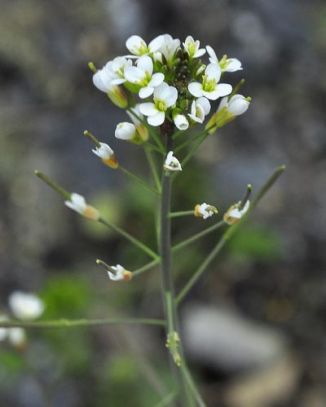This is a most unremarkable plant to look at, straggly, roughly hairy with a basal rosette of oval leaves, toothed or untoothed, which can sometimes be withered by the time the plant flowers. An annual, growing to about 30cm, it bears its little white 4-petalled flowers (3-4mm across) in branched racemes on long spindly stalks from March to October. There are a few small alternate stem leaves. The seeds are borne in long, slightly curved, cylindrical pods (10-18mm long) which spread out from the stalks, arranged in pairs like fishbones. It is found growing on bare waste places, dry sandy soil and old walls, and is also known as Common Wall-Cress and Mouse-ear Cress. This is a native plant and it belongs to the family Brassicaceae
I came across this little plant in Kilkenny town in 2009 when I also photographed it.
If you are satisfied you have correctly identified this plant, please submit your sighting to the National Biodiversity Data Centre
This skinny, spindly little plant whose rather dull appearance means its survival is never endangered by overpicking, is a perfect example of how one shouldn't judge a book by its cover. In a nutshell, Thale Cress has recently been found to be the one single ideal plant for genetic research and has been the main plant for work in Genetic Modification (GM) in the development of herbicide-tolerant crops. It has a very tiny genome (the genetic life-code of the species), and this genome is termed 'clean'. Because the plant is self-pollinating and because it has not been genetically changed by plant breeding, everywhere in the world it grows as a wild plant only, therefore its genes are its very own and not those achieved by cross-fertilisation or any artificial breeding. It grows very quickly, its life cycle lasting about six weeks from germination but in that time it produces masses of seeds. Its short generation cycle therefore makes it ideal for research purposes.
Thale Cress is also being turned to in order to help in the detection of nitrogen dioxide leaking from buried land mines. The plant often has a distinctly reddish hue, usually the result of being under stress due to mineral deficiency or drought. Scientists are now breeding a genetically modified form of this plant which will change colour only when in the presence of nitrogen dioxide. This amazing little plant has been termed by some scientists as possibly the most important plant in the world.




